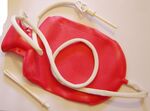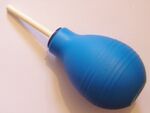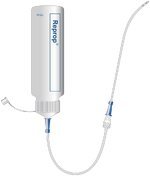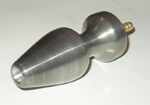Assessment |
Biopsychology |
Comparative |
Cognitive |
Developmental |
Language |
Individual differences |
Personality |
Philosophy |
Social |
Methods |
Statistics |
Clinical |
Educational |
Industrial |
Professional items |
World psychology |
Biological: Behavioural genetics · Evolutionary psychology · Neuroanatomy · Neurochemistry · Neuroendocrinology · Neuroscience · Psychoneuroimmunology · Physiological Psychology · Psychopharmacology (Index, Outline)

This 2qt (about 2 liters) enema bag, or "fountain syringe", equipped with a rectal nozzle, is to be filled with water or a solution, then suspended near the patient using the hook. Then, the nozzle (shown equipped) is inserted into the anus and the clamp is released. This bag may also be used for vaginal douches.

This rectal bulb syringe may be used to administer small enemas.

Enema Device for bowel irrigation
An enema (plural enemata or enemas) is the procedure of introducing liquids into the rectum and colon via the anus. Enemas can be carried out for medical reasons (as a treatment for constipation), as part of alternative therapies, and also for erotic purposes, particularly as part of BDSM activities. In earlier times, they were often known as clysters.
Medical usage
The main medical usages of enemas are:
- As a bowel stimulant, not unlike a laxative -- the main difference being that laxatives are commonly thought of as orally administered while enemas are administered directly into the rectum, and thereafter, into the colon. When the enema is complete, and after a set "holding time," the patient expels feces along with the enema in the toilet.
- Enemas may be used to relieve constipation and fecal impaction, although in many health-care settings their use has been largely replaced by oral laxatives and laxative suppositories. Bowel stimulating enemas may consist of water, which works primarily as a mechanical laxative, or they may be made up of water with baking soda (sodium bicarbonate) or water with a mild soap dissolved in it; sodium phosphate solution, which draws additional water from the bloodstream into the colon and increases the effectiveness of the enema, but which can often be rather irritating to the colon, causing intense cramping or "gripping"; or mineral oil, which functions as a lubricant and stool softener, but which often has the side effect of sporadic seepage from the patient's anus which can soil the patient's undergarments for up to 24 hours. Other types of solutions are available as well. In the past, castile soap was a common additive to enemas, but it has largely fallen out of use because of the risk of chemical colitis as well as the ready availability of other enema preparations that are perhaps more effective than soap -- but which are certainly more irritating to colonic tissues. At the opposite end of the spectrum, an isotonic saline solution is the least irritating and has a neutral osmotic pressure, neither leaching electrolytes from the body, as can happen with plain water, nor drawing water into the colon, as with phosphates, nor adding anything to the bloodstream. Thus it can be used when a longer period of retention is desired, such as to soften an impaction.
- Cleansing the lower bowel prior to a surgical procedure such as sigmoidoscopy or colonoscopy. Because of speed and supposed convenience, enemas used for this purpose are commonly the sodium phosphate variety. A more pleasant experience can usually be obtained with gently-administered baking soda enemas; cleansing the lower bowel for colonoscopy and other bowel studies can be effectively achieved with water-based enema administration.
- The administration of substances into the bloodstream. This may be done in situations where it is undesirable or impossible to deliver a medication by mouth, such as antiemetics given to reduce nausea (though not all antiemetics are delivered by enema). Additionally, several anti-angiogenic agents can be safely administered via a gentle enema. Medicines for cancer, for arthritis, and for age-related macular degeneration are often given via enema in order to avoid digestion in the normally-functioning digestive tract. Interestingly, some water-based enemas are also used as a relieving agent for Irritable Bowel Syndrome. Finally, an enema may also be used for hydration purposes. See also route of administration.
- The topical administration of medications into the rectum, such as corticosteroids and mesalazine used in the treatment of inflammatory bowel disease. Administration by enema avoids having the medication pass through the entire gastrointestinal tract, therefore simplifying the delivery of the medication to the affected area and limiting the amount that is absorbed into the bloodstream.
- General anesthetic agents for surgical purposes are sometimes administered by way of an enema. Occasionally, anesthetic agents are used rectally to reduce medically-induced vomiting during and after surgical procedures, in an attempt to avoid aspiration of stomach contents.
- A barium enema is used as a contrast substance in the radiological imaging of the bowel. The enema may contain barium sulfate powder, or a water-soluble contrast agent. Barium enemas are sometimes the only practical way to "view" the colon in a relatively safe manner.
In certain countries such as the United States, customary enema usage went well into the 20th century; it was thought a good idea to cleanse the bowel in case of fever; also, pregnant women were given enemas prior to labor, supposedly to reduce the risk of feces being passed during contractions. Under some controversial discussion, pre-delivery enemas were also given to women to speed delivery by inducing contractions. This latter usage has since been largely abandoned, because obstetricians now commonly give oxytocin to induce labor and because women generally found the procedure unpleasant.
Home usage
Many home-given enemas are pre-packaged sodium phosphate solutions in single-use bottles sold under a variety of brand names, or in generic formats. These units come with a pre-lubricated nozzle attached to the top of the container. Some enemas are administered using so-called disposable bags connected to disposable tubing (despite the names, such units can commonly be used for many months or years without significant deterioration).
Patients who want easier, more gently-accepted enemas often purchase Combination Enema Syringes which are commonly referred to as "closed top" syringes, and which can also be used as old-fashioned hot water bottles, so as to relieve aches and pains via gentle heat administrations to parts of the body.
In medical or hospital environments, reusable enema equipment is now rare because of the expense of administering and disinfecting a water-based solution. For a single-patient stay of short duration, an inexpensive disposable enema bag can be used for several days or weeks, using a simple rinse out procedure after each enema administration. The difficulty comes in from the longer time period (and expense) required of nursing aides to give a gentle, water-based enema to a patient, as compared to the very few minutes it takes the same nursing aide to give the more irritating, cold, pre-packaged sodium phosphate unit.
For home use, disposable enema bags or bottles are common, but reusable rubber or vinyl bags or enema bulbs may also be used. In former times, enemas were infrequently administered using clyster syringes. If such commercially-available items are not at hand, ordinary water bottles are sometimes used.
Enemas in eating disorders
Some people suffering from eating disorders such as Anorexia nervosa and Bulimia use enemas as an adjunct to their other practices for controling their weight (eg laxatives)
Colonic irrigation
Colonic irrigation or colon hydrotherapy is a large enema which cleanses the whole colon. It was in vogue for hygienic purposes at the beginning of the 20th century (see John Harvey Kellogg) and remains popular as an alternative health therapy in many parts of the world. Advocates believe that, when carried out by trained personnel using sterile equipment, it can be a safe and valuable tool for eliminating toxins from the body and restoring normal muscular activity in the colon. However, there have been cases of intestinal perforation due to improperly done colonic irrigations. The actual medical benefit of colonic irrigation is controversial.
Non-medical usage

An aluminium enema nozzle. Specialty nozzles are common for non-medical usage, and are available in a huge variety of sizes, styles, and materials.
- The paraphilia directed towards enemas is known as klismaphilia. Klismaphilia is the enjoyment of enema applications because of the pleasurable sensations which they give to many people. In males, enemas put pressure on the prostate gland and can increase the intensity of orgasm and the volume of ejaculation.
- In some cities, enemas are available as a service from practitioners in the sex industry to cater to klismaphiliac desires, and may be used as part of BDSM activities. Some providers require a physician's prescription before they will give an enema, and others will merely give enemas on request to clients who like or need them.
- A small enema may also be used prior to anal sex or anilingus in order to remove feces, thus reducing bacterial transmission and risk of infection. Or, some people who enjoy anal sex activities use enemas to enhance their sensations during the act. Finally, some people who enjoy anal sex also use a small enema or two to reduce the possibility of fecal material adhering to the sex tool(s) used by themselves or their partners during sexual activity.
- People who wish to become intoxicated faster have also been known to use enemas as a method to instill alcohol into the bloodstream, absorbed through the membranes of the large intestine. However, great care must be taken as to the amount of alcohol used. Only a small amount is needed as the intestine absorbs the alcohol more quickly than the stomach. Deaths have resulted due to alcohol poisoning via enema.[How to reference and link to summary or text]
Ritual use
- Ritual enemas were practiced by the Maya and many other North American , Central American and South American Indian tribes; some tribes have continued the practice to the present day. Substances used in the enemas include alcohol, tobacco, peyote, and other hallucinogenic drugs and entheogens. The Maya used a fermented liquid called balché in their enemas.[How to reference and link to summary or text]
References
- M. R. Strict, Intimate Invasion: The Erotic Ins & Outs of Enema Play, Greenery Press, 2004. ISBN 1-890159-51-4.
See also / External links
- Dry enema
- Enema bandit
- An Enema Enthusiasts Web Group :
- http://grou.ps/enemaexploration/home*
- An enema enthusiast website